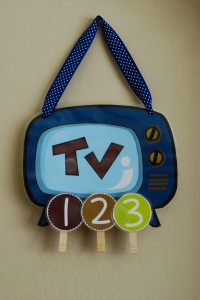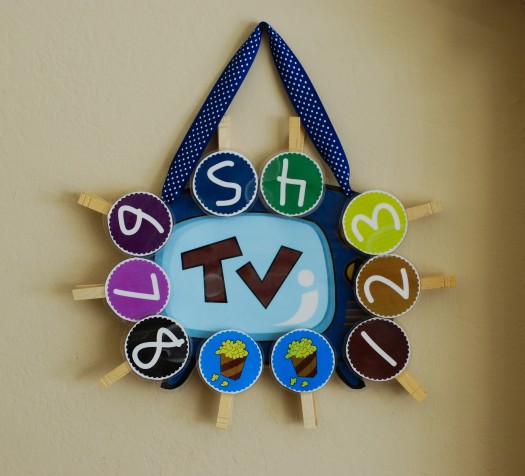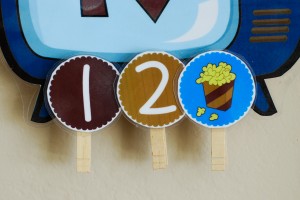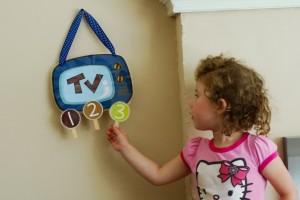 Before I had kids, I always planned that when I did have them, I would limit their TV time. I never said I wasn’t going to let them have any, I just wanted to be sure they didn’t get a ton.
Before I had kids, I always planned that when I did have them, I would limit their TV time. I never said I wasn’t going to let them have any, I just wanted to be sure they didn’t get a ton.
I am not one that thinks TV is the devil…well not exactly anyway. I am one that believes strongly in moderation. For the most part, I want my kids to be playing, drawing, painting, creating, or reading and not just sitting on the couch staring at a screen hanging on the wall. But sometimes I also think a little TV is ok.
Note I said a little.
Lately, we have been having a little issue with my daughter understanding just how much TV is ok. Let’s just say sometimes she is not thrilled when I say no to TV (and by not thrilled I mean whining, crying, and generally throwing a fit). So I decided to use some of my professional background in visual schedules and reinforcement charts to create a TV Time Chart to help my daughter see visually how much TV she is allowed to watch in a day.
How I Did It

- I found a cool retro TV clip art at Graphics Factory (where I have a membership). I altered the colors and then printed it out on card stock, cut it out, and laminated it. I then punched holes in the top, strung some ribbon through, and hung it on the wall in our family room.
- I created 8 colored circles in different colors and numbered them 1-8. I printed on card stock, cut them out, and laminated them as well. Each circle represents a TV show (or an increment of time…more info below)
- I created two circles with a clip art picture of popcorn on them. These represent a movie (vs. a TV show)
- I hot glued all the circles onto clothes pins so that they can be attached onto the TV.
 How I Use It

- I hung the TV in the family room near the TV so that it can be easily used.
- Each numbered circle clip represents ONE TV show (the ones my kids are allowed to watch are generally 20 minutes long).
- In the morning, I attach the number of clips on the TV that they are allowed to use that day.
- In order to be able to watch a show, my child must ask me to watch a show, and if I say OK, she must give me one of the clips. We talk about how many clips she has left so
 that she is always aware that at some point, there will no longer be anymore TV.
that she is always aware that at some point, there will no longer be anymore TV. - MOVIES: In order to watch a movie she has trade in 2 or 3Â of her clips to get the movie clip (depending on the day, what we have going on…etc). I also randomly put out a movie clip on days that I may need to get something done (or days we may not feel well and just need to relax).
- Variations: Rather than having each clip represent one show…you can have each clip represent an increment of time (and therefore work on math skills!) They could each represent 5 or 10 minutes each and you can have the (older) child figure out just how many clips they will need to have to trade in to watch a show or movie. Also, rather than having a set amount of TV a day, you may choose to do it per WEEK, and teach your children how to spread it out over the week (maybe for older kids?). For us, 2-3 shows a day works great. Other days, only ONE works great too 😉
- **Update January 2014: Using this chart REALLY helped our family decrease TV time and increase our time playing, doing art, playing outside, etc. Now my older children are 5 and 3 and both are allowed to pick only one show a day (on days I allow TV) and that concept works well for us. Sometimes, “Mommy picks a show” too…when things get a little crazy and I need 20 minutes to chill out 😉
Why it works
Time is a very hard concept for little ones to understand. You can’t see it. A great example is when we say “E, 10 minutes until bedtime” and she then retorts with “No mommy! 5 more minutes!” For little ones who are just beginning to understand that some numbers are bigger than others (like my daughter) this makes it even more difficult to understand time. Even if we told her that she can only watch 2 or 3 shows a day….the concept of “how many” is also something that at age 3 1/2 she is just starting to grasp. So giving a child some sort of visual example of time and quantity can allow them to understand exactly what they can/can’t have. Providing a child with a visual schedule or visual chart can help to decrease frustrations and tantrums and help them actually learn the concepts of time, time management, quantity, and so on.
It is also a way for YOU to keep track of things and stay consistent!
Since it is Freebie Friday (a tad early)…I am going to share my TV Time Chart with you for FREE! You can download your own copy HERE. (Note: you will notice the colors of the number clips are different than mine in the pictures…that is because my printer was low on red when I printed mine! Ooops. I like it anyway though 😉 )
If you use this..please come back and let me know how you like it!
Cheers!
Great idea – I created my own version, and linked back to your post on my website:
http://threecountiesmum.blogspot.co.uk/2012/07/tv-scheduler.html
Thanks!
Three Counties Mum recently posted..TV Scheduler
Love this idea thank you!
This is SO great! I have a four and a six-year-old and I actually use it with both of them. It is a great way to manage summer and winter break days for my school-age son who seems to lose all sense of time when the TV is on; and of course my four-year-old loves it! Thanks for posting the free download. It has helped our family immensely!
Trisha I am SO happy to hear that this is helping another family!
I have just found your blog post on managing TV time- it looks fantastic and ti be just what I was looking for!! I have just printed it and can’t wait to try it with my 3 and 5 year olds!!! Thank you thank you!!!
PS… You just saved my after school drama and summer weekends 😀 LOVE IT! & Ty for sharing your personal experience in update !
Jeanine recently posted..Kids Free Printable {re-blog}
I really love this idea! My son asks for tv right away in the morning. He is not allowed to watch it until after lunch. I can’t wait to start this.
Katie, This is fantastic! We have been using this for the last week with our six-year-old daughter, and we’re all happy. The guidelines are clear, which is what we’ve needed in terms of screen time. Thank you for making it a free resource!
I will also definitely be going through a lot more of your blog as I look for new ideas to use with my three-year-old son who has Down syndrome. We’re always working on his speech, so it’s fun to have fresh ideas.
Thank you!
Angela